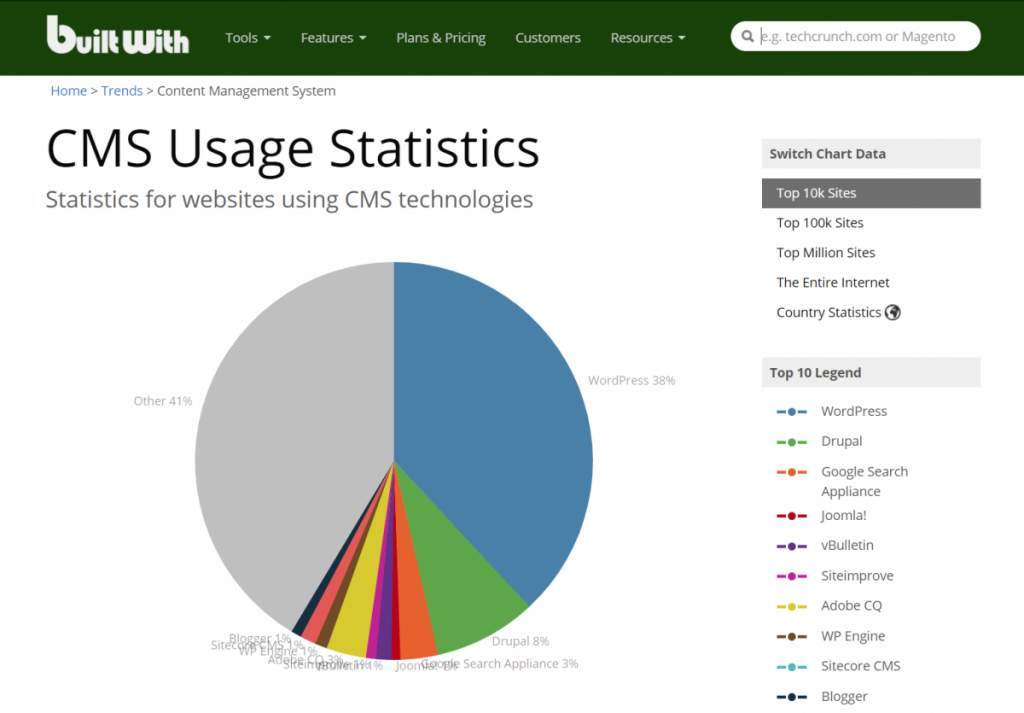WordPress 2017: More and More Sites Use the Popular CMS

WordPress is popular, but people like to claim it was dying at times. Several recent statistics show that the CMS is more alive than ever.
 Built With: Recent Statistics. (Screenshot: Noupe)[/caption]
It's pretty clear that with lowering significance and increasing cost relevance, the tendency for using WordPress rises. For small and medium-sized websites, WordPress is pretty much the logical choice. Ten thousands of plugins and themes leave almost no need uncovered. There's barely anything that can't be done with WordPress (almost always for free).
Built With: Recent Statistics. (Screenshot: Noupe)[/caption]
It's pretty clear that with lowering significance and increasing cost relevance, the tendency for using WordPress rises. For small and medium-sized websites, WordPress is pretty much the logical choice. Ten thousands of plugins and themes leave almost no need uncovered. There's barely anything that can't be done with WordPress (almost always for free).
Inc. 5000: WordPress is Not Only for the Poor
For three years now, the team of Nelio Software from Barcelona, Spain, has been investigating the dissemination of WordPress as an engine of the websites of the 5,000 fastest growing businesses of the year. The foundation is the list Inc 5000 from Inc.com. In 2015, WordPress already made up a share of over 42 percent amongst the top 100 of the Inc. 5000. In 2016, this value jumped to over 60 percent, while settling at a slightly lower level of 54 percent in 2017. The spread among the top 100 of the Inc. 5000 is especially interesting, as these businesses are heavyweights where the website costs are only a subordinate factor.Of Course, WordPress is Especially Interesting for "the Poor"
This effect is pretty clear when looking at the more general CMS usage statistics on Built With. In the top 10,000 websites, WordPress makes up an impressive share of 38 percent. In the top 100,000, the share is 43 percent, and it's at 51 percent in the top million. [caption id="attachment_103545" align="aligncenter" width="1024"] Built With: Recent Statistics. (Screenshot: Noupe)[/caption]
It's pretty clear that with lowering significance and increasing cost relevance, the tendency for using WordPress rises. For small and medium-sized websites, WordPress is pretty much the logical choice. Ten thousands of plugins and themes leave almost no need uncovered. There's barely anything that can't be done with WordPress (almost always for free).
Built With: Recent Statistics. (Screenshot: Noupe)[/caption]
It's pretty clear that with lowering significance and increasing cost relevance, the tendency for using WordPress rises. For small and medium-sized websites, WordPress is pretty much the logical choice. Ten thousands of plugins and themes leave almost no need uncovered. There's barely anything that can't be done with WordPress (almost always for free).
The REST API Will be the Next Growth Engine for WordPress
For the future, we should expect WordPress to establish its position at the top even more. With the REST API and the keywordHeadless CMS, applications that could not be created with the system before, become possible.
The REST API allows you to basically use WordPress as a data backend, while the frontend application can be created completely independently, and does not need to be related to WordPress outside of the API access. This also explains the term headless. WordPress is robbed of its visible part and only runs as the engine under a completely different hood.
For the small, and medium web presences, this won't really matter. Here, I expect bigger changes from the new Gutenberg editor, which will become available in April of 2018, with WordPress 5.
